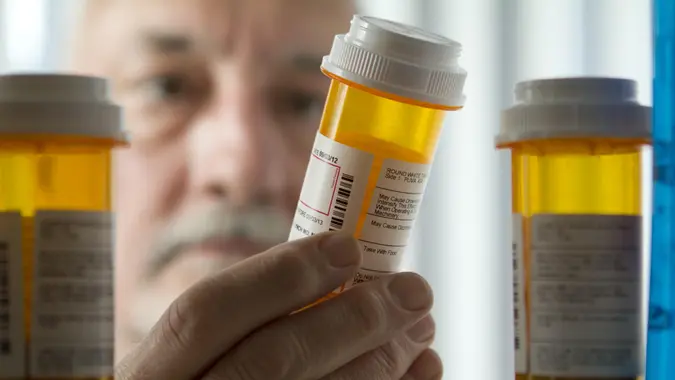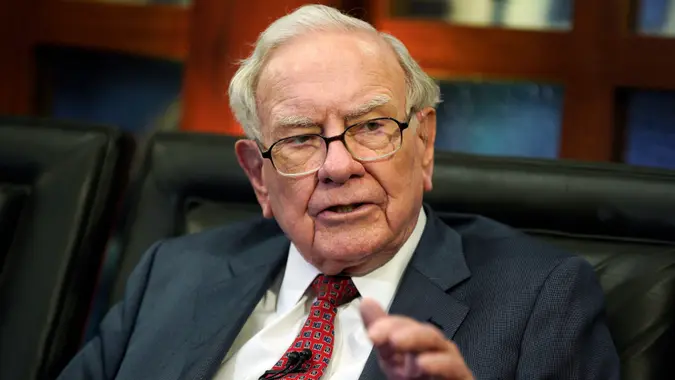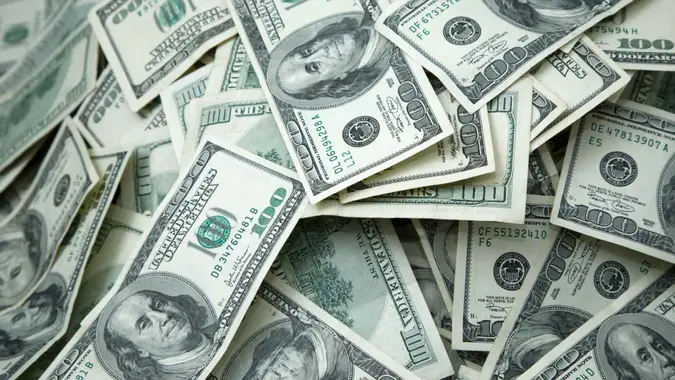Here’s How Trump’s Prescription Drug Order Could Offset Inflation

Commitment to Our Readers
GOBankingRates' editorial team is committed to bringing you unbiased reviews and information. We use data-driven methodologies to evaluate financial products and services - our reviews and ratings are not influenced by advertisers. You can read more about our editorial guidelines and our products and services review methodology.

20 Years
Helping You Live Richer

Reviewed
by Experts

Trusted by
Millions of Readers
President Donald Trump’s second term has been characterized by a barrage of executive orders. One of the most noteworthy was his May 12 announcement that he would lower the cost of prescription drugs. If actually put into place, this could potentially affect hundreds of millions of people in the United States, as roughly two-thirds of Americans take at least one prescription drug, according to Georgetown University’s Health Policy Institute.
With so much on the line, here’s a closer look at the actual substance of the executive order, what it could mean for prices in America and how likely it is that it actually takes effect.
What Was the Actual Directive of the Executive Order?
The prescription drug order Trump signed on May 12 set a 30-day deadline for pharmaceutical companies to willingly lower the cost of their drugs in the United States or face ramifications. Specifically, if drugmakers don’t willingly comply with the mandate, Trump says the U.S. will only pay the same low prices as other countries.
According to Reuters, residents of the United States pay the most for prescription drugs in the world, often three times as much as in other countries. In some cases, the disparity is even higher. The blood thinner Eliquis, for example, lists for $606 monthly in the United States but sells for just $114 in Sweden and $20 in Japan.
How Much Do Drug Costs Contribute To Inflation?
It’s not just high list prices that make drugs so costly in America. It’s also the fact that their costs increase frequently. According to data from the Federal Reserve Bank of St. Louis, drug prices rose three times faster than the rate of inflation from 1985 to 2024.
Viewed another way, the data shows that drug prices in 2024 were more than five times as high as they were in 1985. This means that drug prices are a significant contributor to inflation and a major expense for many American households. Any relief that Trump’s executive order could provide would no doubt be very welcome.
Can Trump’s Executive Order Offset Inflation?
If Trump were to achieve the goal of his executive order, it would indeed help offset inflation. As rising drug prices are such an important contributor to overall inflation, reversing the trend would by definition help lower inflation.
However, it’s important to understand that the specifics of the executive order, such as what drugs it might target, are still unclear. While hoping for a broad 30% to 80% reduction in the price of drugs, there’s as yet no telling just what drugs might be affected or even if the order could actually be implemented.
Are There Any Obstacles to Implementation?
There are a large number of obstacles that could stand in the way of Trump’s executive order. For starters, Trump can’t make any sweeping changes without the support of legislation drafted by Congress. And although the Republicans have a majority in both houses, many in Trump’s own party see problems with the plan. According to The Associated Press, Republican Senate Majority Leader John Thune said it would be “fairly controversial” if Trump attempted to enact legislation of this nature, as his party has long been against using Medicare to pressure drug companies.
Many have forgotten that Trump already tried to enact a similar plan at the end of his first term, when he signed an executive order mandating essentially the same thing. That plan was blocked by a court order in December 2020, nullifying it shortly before Trump left office the following January, according to the AP.
Another major obstacle would be the pharmaceutical industry itself. With one of the most powerful and well-funded lobbies in America, there’s no doubt it would aggressively fight such a mandate.
Still, if Trump simply plans to leverage the executive order to negotiate some concessions on the part of the drug companies, it may prove effective in at least a limited way.
Editor’s note on political coverage: GOBankingRates is nonpartisan and strives to cover all aspects of the economy objectively and present balanced reports on politically focused finance stories. You can find more coverage of this topic on GOBankingRates.com.
More From GOBankingRates
Sources
- George Town University, “Prescription Drugs.”
- Federal Reserve Bank of St. Louis, “Pharmaceutical and Medicine Manufacturing.”
 Written by
Written by  Edited by
Edited by 

























